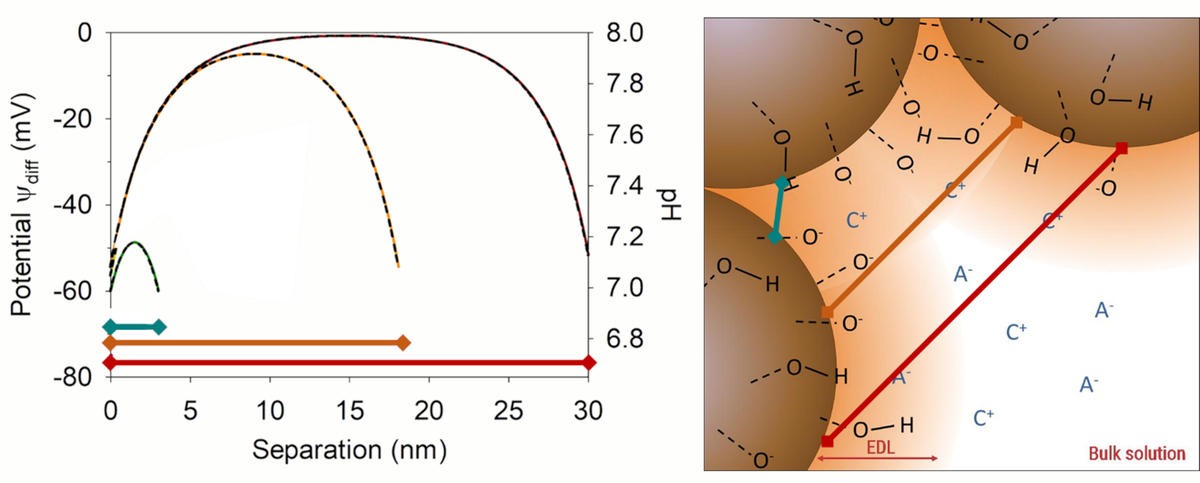Geochemical Modelling
For safety analyses of deep geological repositories for radioactive waste, it is necessary to make predictions of radionuclide migration. Though, geological or geo-technical barrier systems may to some extent prevent groundwater contacting the radioactive waste, intrusion of solutions into disposal sites has to be taken into account within the long-term safety case of a repository. In the near-field of a deep geological repository it is usually assumed that water intrusion mobilizes radionuclides that are present in the waste forms. Some are not limited by solubility limits (instant release fraction), while others are. Once mobilized, radionuclides undergo aqueous speciation reactions, which depend on the solution composition in general, and in particular on the pH, the redox potential, and the ionic strength. Many radionuclides also interact with the various surfaces present. This may be for example (corroding/corroded) waste containers, barrier materials, or host-rock materials. Geochemical Modelling allows to simulate all these reactions in principle, and when coupled to hydrodynamics or diffusion models, it is also possible to predict the migration of contaminants in the environment.
The aims of the work that is pursued in this group are related to the speciation of radionuclides in the solution (solution complexation and solubility) and at interfaces (surface complexation modeling). The geochemical models are intended to give input into safety analyses for various host-rock types using state of the art approaches.
The group uses various codes to carry out a range of thermodynamic and reactive transport calculations. The codes include both commercial (The Geochemist’s workbench, https://www.gwb.com/) and freeware (Visual MINTEQ, https://vminteq.com/, PHREEQC, https://www.usgs.gov/software/phreeqc-version-3 ) software for state-of-the-art speciation calculations related to nuclear waste storage and radionuclide transport. We cover aqueous solutions from dilute to saturated conditions, and have expertise in models for calculating activity coefficients using SIT or Pitzer approaches. Here, we were the first to design surface complexation models up to extreme salt levels including Pitzer for aqueous solutions and non-electrostatic (https://www.sciencedirect.com/science/article/pii/S0016703714006814 ) or electrostatic (https://www.sciencedirect.com/science/article/pii/S092777571930593X) surface complexation models using high-quality experimental data.
Our main expertise clearly lies in modeling interfacial equilibria using electrostatic surface complexation models, where we not only develop and parameterize model concepts, we also write computer programs for applications that are not included in available codes.
A recent example is the charge regulation code SINFONIA (https://www.sciencedirect.com/science/article/pii/S000186862100110X), which implements aqueous speciation and surface equilibria for cases where electrical double layers between two surfaces overlap at small distances, as sketched in Figure 1.
The modeling typically includes both forward (predictions, simulations with known parameters) and inverse (parameter estimation based on high quality experimental and molecular simulation results) with the ambition to include a maximum of process understanding in the models whenever possible.
We have a strong interest in interfacial phenomena in general and favor a combined experimental and modelling approach (https://pubs.acs.org/doi/full/10.1021/acs.chemrev.2c00130) with specific focus on radionuclides (https://pubs.acs.org/doi/10.1021/cr300370h). Beyond static batch-type experiments, experimental in-house approaches include electrokinetics (electrophoretic mobility, streaming potential), column experiments (to test adsorption models in reactive transport situations) or quartz crystal microbalance (to gain quantitative data on dissolution and adsorption phenomena, typically coupled with electrokinetics), and cutting-edge approaches like non-linear optical methods or surface diffraction experiments with external collaborators. The aim is to gain a maximum of information on a target system, to be subsequently included into advanced models (https://pubs.rsc.org/en/content/articlelanding/2015/fd/c4fd00260a), which may ultimately lead to models that can for example simulate the retention of radionuclides on barriers in a nuclear waste repository on a mechanistic level (https://www.sciencedirect.com/science/article/pii/S0021979719313657).
The experimental techniques and molecular simulation approaches are applied in close collaboration within the institute but also with colleagues from outside KIT.
The expertise in surface complexation models has resulted in a book on the topic (https://www.sciencedirect.com/bookseries/interface-science-and-technology/vol/11/suppl/C) and a prestigious short course with two volumes in the “Reviews in Mineralogy and Geochemistry” series (https://pubs.geoscienceworld.org/rimg, Vol. 91, in progress).
Besides geochemical models, transport simulations are performed for the numerical description of diffusion processes from the lab (cm) to the underground research lab (m) scale. Diffusion models are developed in Phython, employing the finite element library FEnics (https://fenicsproject.org/). An exemplary model for a laboratory test of radiotracer diffusion through a bentonite disk performed by colleagues at INE is shown in Figure 2.
Fig. 2: Exemplary diffusion simulation for radiotracer diffusion out of glas vials, which were embedded in a bentonite ring. Layout of the model is shown on the left, highlighting the mesh and the model domains. The insert shows the real experiment. The right shows the predicted radionuclide distribution within the domain after 347 days.
Contact:
|
+49 721 608 24023 |


